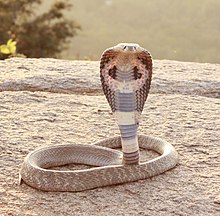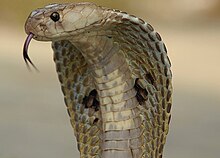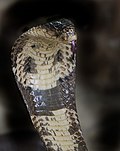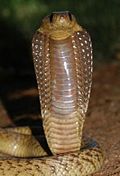Naja
| Naja | |
|---|---|

| |
| Indian cobra (Naja naja), species typica of the genus | |
| Scientific classification | |
| Domain: | Eukaryota |
| Kingdom: | Animalia |
| Phylum: | Chordata |
| Class: | Reptilia |
| Order: | Squamata |
| Suborder: | Serpentes |
| Family: | Elapidae |
| Genus: | Naja Laurenti, 1768 |
| Type species | |
Coluber naja Linnaeus, 1758
| |
Naja is a
Until recently, the genus Naja had 20 to 22


Etymology
The origin of this genus name is from the
Description
Naja species vary in length and most are relatively slender-bodied snakes. Most species are capable of attaining lengths of 1.84 m (6.0 ft). Maximum lengths for some of the larger species of cobras are around 3.1 m (10 ft), with the
Venom
All species in the genus Naja are capable of delivering a fatal bite to a human. Most species have strongly
Several Naja species, referred to as
A recent study[12] showed that all three spitting cobra lineages have evolved higher pain-inducing activity through increased phospholipase A2 levels, which potentiate the algesic action of the cytotoxins present in most cobra venoms. The timing of the origin of spitting in African and Asian Naja species corresponds to the separation of the human and chimpanzee evolutionary lineages in Africa and the arrival of Homo erectus in Asia. The authors therefore hypothesise that the arrival of bipedal, tool-using primates may have triggered the evolution of spitting in cobras.
The Caspian cobra (N. oxiana) of Central Asia is the most venomous Naja species. According to a 2019 study by Kazemi-Lomedasht et al, the murine LD50 via intravenous injection (IV) value for Naja oxiana (Iranian specimens) was estimated to be 0.14 mg/kg (0.067-0.21 mg/kg)[13] more potent than the sympatric Pakistani Naja naja karachiensis and Naja naja indusi found in far north and northwest India and adjacent Pakistani border areas (0.22 mg/kg), the Thai Naja kaouthia (0.2 mg/kg), and Naja philippinensis at 0.18 mg/kg (0.11-0.3 mg/kg).[14] Latifi (1984) listed a subcutaneous value of 0.2 mg/kg (0.16-0.47 mg/kg) for N. oxiana.[15] The crude venom of N. oxiana produced the lowest known lethal dose (LCLo) of 0.005 mg/kg, the lowest among all cobra species ever recorded, derived from an individual case of envenomation by intracerebroventricular injection.[16] The Banded water cobra's LD50 was estimated to be 0.17 mg/kg via IV according to Christensen (1968).[17][18] The Philippine cobra (N. philippinensis) has an average murine LD50 of 0.18 mg/kg IV (Tan et al, 2019).[14] Minton (1974) reported 0.14 mg/kg IV for the Philippine cobra.[19][20][21] The Samar cobra (Naja samarensis), another cobra species endemic to the southern islands of the Philippines, is reported to have a LD50 of 0.2 mg/kg,[22] similar in potency to the monocled cobras (Naja kaouthia) found only in Thailand and eastern Cambodia, which also have a LD50 of 0.2 mg/kg. The spectacled cobras that are sympatric with N. oxiana, in Pakistan and far northwest India, also have a high potency of 0.22 mg/kg.[14][23]
Other highly venomous species are the 'forest cobras' and/or 'water cobras' (Boulengerina subgenus) are also highly venomous. The murine intraperitoneal
The Naja species are a medically important group of snakes due to the number of bites and fatalities they cause across their geographical range. They range throughout
Many factors influence the differences in cases of fatality among different species within the same genus. Among cobras, the cases of fatal outcome of bites in both treated and untreated victims can be quite large. For example, mortality rates among untreated cases of envenomation by the cobras as a whole group ranges from 6.5–10% for N kaouthia.
Taxonomy
| Naja |
| |||||||||||||||||||||||||||||||||||||||||||||||||||||||||||||||||||||||||||||||||||||||||||||||||||||||||||||||||||||||||||||||||||||||||||||||||||||||||||||||||||||||||||||||||
The genus contains several species complexes of closely related and often similar-looking species, some of them only recently described or defined. Several recent taxonomic studies have revealed species not included in the current listing in ITIS:[5][37]
- Naja arabica Scortecci, 1932, the Arabian cobra, has long been considered a subspecies of N. haje, but was recently raised to the status of species.[40]
- Naja ashei Broadley and Wüster, 2007, Ashe's spitting cobra, is a newly described species found in Africa and also a highly aggressive snake; it can spit a large amount of venom.[41][42]
- Naja nigricincta Bogert, 1940, was long regarded as a subspecies of N. nigricollis, but was recently found to be a full species (with N. n. woodi as a subspecies).[43][44]
- Naja senegalensis Trape et al., 2009, is a new species encompassing what were previously considered to be the West African savanna populations of N. haje.[40]
- Naja peroescobari Ceríaco et al. 2017, is a new species encompassing what was previously considered the São Tomé population of N. melanoleuca.[45]
- Naja guineensis Broadley et al., 2018, is a new species encompassing what were previously considered to be the West African forest populations of N. melanoleuca.[7]
- Naja savannula Broadley et al., 2018, is a new species encompassing what were previously considered to be the West African savanna populations of N. melanoleuca.[7]
- Naja subfulva Laurent, 1955, previously regarded as a subspecies of N. melanoleuca, was recently recognized as a full species.[7]
Two recent molecular phylogenetic studies have also supported the incorporation of the species previously assigned to the genera
The controversial amateur herpetologist Raymond Hoser proposed the genus Spracklandus for the African spitting cobras.[47] Wallach et al. suggested that this name was not published according to the Code and suggested instead the recognition of four subgenera within Naja: Naja for the Asiatic cobras, Boulengerina for the African forest, water and burrowing cobras, Uraeus for the Egyptian and Cape cobra group and Afronaja for the African spitting cobras.[6] International Commission on Zoological Nomenclature issued an opinion that it “finds no basis under the provisions of the Code for regarding the name Spracklandus as unavailable”.[48]
Asiatic cobras are believed to further be split into two groups of southeastern Asian cobras (N. siamensis, N. sumatrana, N. philippinensis, N. samarensis, N. sputatrix, and N. mandalayensis) and western and northern Asian cobras (N. oxiana, N. kaouthia, N. sagittifera, and N. atra) with Naja naja serving as a basal lineage to all species.[49]
Species
| Image[5] | Species[5] | Authority[5] | Subsp.*[5] | Common name | Geographic range |
|---|---|---|---|---|---|
| N. anchietae | Bocage, 1879 | 0 | Anchieta's cobra (Angolan Cobra) | Angola, Botswana, Namibia, Zambia, eastern Zimbabwe | |

|
N. annulata | (Buchholz and Peters, 1876) | 1 | Banded water cobra
|
Cameroon, the Central African Republic, the Democratic Republic of the Congo (Zaire), the Republic of Congo, Equatorial Guinea, Gabon, Rwanda, and the province of Cabinda in Angola |

|
N. annulifera | Peters, 1854 | 0 | Snouted cobra | Botswana, Malawi, Mozambique, South Africa, Swaziland, Zambia, Zimbabwe |
| †N. antiqua | Rage, 1976 | 0 | Miocene-aged strata of Morocco | ||
| N. arabica | Scortecci, 1932 | 0 | Arabian cobra | Oman, Saudi Arabia, Yemen | |
| N. ashei | Wüster and Broadley, 2007 | 0 | Ashe's spitting cobra (giant spitting cobra)
|
southern Ethiopia, Kenya, Somalia, eastern Uganda | |

|
N. atra | Cantor , 1842
|
0 | Chinese cobra | southern China, northern Laos, Taiwan, northern Vietnam |
| N. christyi | (Boulenger, 1904) | 0 | Congo water cobra
|
the Democratic Republic of the Congo (Zaire), the Republic of Congo, and the province of Cabinda in Angola | |
| N. fuxi |
Shi, Vogel, Chen, & Ding, 2022 |
0 | Brown banded cobra | China, Myanmar, Laos, Thailand, Vietnam | |
| N. guineensis | Broadley, Trape, Chirio, Ineich &Wüster, 2018 | 0 | Black forest cobra | Ghana, Guinea, Guinea-Bissau, the Ivory Coast, Liberia, Sierra Leone, Togo | |

|
N. haje | Linnaeus, 1758 | 0 | Egyptian cobra | Tanzania, Kenya, Somalia, Ethiopia, Uganda, South Sudan, Sudan, Cameroon, Nigeria, Niger, Burkina Faso, Mali, Senegal, Mauritania, Morocco, Algeria, Tunisia, Libya, and Egypt |
| †N. iberica | Szyndlar, 1985 | Miocene-aged strata of Spain | |||

|
N. kaouthia | Lesson , 1831
|
0 | Monocled cobra | Bangladesh, Bhutan, Burma, Cambodia, southern China, eastern India, Laos, northwestern Malaysia, Nepal, Thailand, southeastern Tibet, Vietnam |

|
N. katiensis | Angel, 1922 | 0 | Mali cobra (Katian spitting cobra) | Benin, Burkina Faso, Cameroon, Ghana, Guinea, the Ivory Coast, Mali, Gambia, Mauritania, Niger, Nigeria, Senegal, Togo |

|
N. mandalayensis | Slowinski & Wüster, 2000 | 0 | Mandalay spitting cobra (Burmese spitting cobra) | Myanmar (Burma) |

|
N. melanoleuca | Hallowell, 1857 | 0 | Central African forest cobra | Angola, Benin, Cameroon, the Central African Republic, the Republic of Congo, the Democratic Republic of the Congo (Zaire), Equatorial Guinea, Gabon, Nigeria |

|
N. mossambica | Peters, 1854 | 0 | Mozambique spitting cobra | extreme southeastern Angola, Botswana, Malawi, Mozambique, Somalia, northeastern Namibia, South Africa, Swaziland, Tanzania (including Pemba Island), Zambia, Zimbabwe |
| N. multifasciata | Werner, 1902 | 0 | Many-banded cobra
|
Cameroon, Congo, the Democratic Republic of the Congo (Zaire), Gabon | |

|
N. naja | (Linnaeus, 1758) | 0 | Indian cobra (spectacled cobra) | Bangladesh, Bhutan, India, Nepal, Pakistan, Sri Lanka |

|
N. nana | Collet & Trape, 2020 | 0 | Dwarf water cobra | Democratic Republic of Congo |

|
N. nigricincta | Bogert, 1940 | 1 | Zebra spitting cobra
|
Angola, Namibia, South Africa |

|
N. nigricollis | Reinhardt, 1843 | 0 | Black-necked spitting cobra | Angola, Benin, Burkina Faso, Burundi, Cameroon, the Central African Republic, Chad, the Democratic Republic of the Congo (Zaire) (except in the central region), Congo, Ethiopia, Gabon, Gambia, Ghana, Guinea-Bissau, Guinea, the Ivory Coast, Kenya, Liberia, Mali, Mauritania, Namibia, Niger, Nigeria, Rwanda, Senegal, Sierra Leone, Sudan, Tanzania, Somalia, Togo, Uganda, Zambia |

|
N. nivea | (Linnaeus, 1758) | 0 | Cape cobra (yellow cobra) | Botswana, Lesotho, Namibia, South Africa |

|
N. nubiae | Wüster & Broadley, 2003 | 0 | Nubian spitting cobra | Chad, Egypt, Eritrea, Niger, Sudan |

|
N. oxiana | (Eichwald, 1831) | 0 | Caspian cobra | Afghanistan, northwestern India, Iran, Kyrgyzstan, Pakistan, Tajikistan, Turkmenistan, Uzbekistan |

|
N. pallida | Boulenger, 1896 | 0 | Red spitting cobra | Djibouti, Ethiopia, Kenya, Somalia, Tanzania |
| N. peroescobari | Ceríaco, Marques, Schmitz & Bauer, 2017 | 0 | São Tomé forest cobra, cobra preta | São Tomé and Príncipe (São Tomé) | |

|
N. philippinensis | Taylor, 1922 | 0 | Philippine cobra | the Philippines (Luzon, Mindoro) |
| †N. romani | (Hofstetter, 1939) | 0 | † | Miocene-aged strata of France, Germany, Austria, Russia, Hungary, Greece and Ukraine.[50] | |

|
N. sagittifera | Wall, 1913 | 0 | Andaman cobra | India (the Andaman Islands) |

|
N. samarensis | Peters, 1861 | 0 | Samar cobra | the Philippines (Mindanao, Bohol, Leyte, Samar, Camiguin) |

|
N. savannula | Broadley, Trape, Chirio & Wüster, 2018 | 0 | West African banded cobra | Benin, Burkina Faso, Cameroon, Chad, Gambia, Ghana, Guinea, the Ivory Coast, Mali, Niger, Nigeria, Senegal, Togo |
| N. senegalensis | Trape, Chirio & Wüster, 2009 | 0 | Senegalese cobra | Benin, Burkina Faso, Ghana, Guinea, Mali, Niger, Nigeria, Senegal | |

|
N. siamensis | Laurenti, 1768 | 0 | Indochinese spitting cobra | Cambodia, Laos, Thailand, Vietnam |

|
N. sputatrix | F. Boie, 1827 | 0 | Javan spitting cobra | Indonesia (Java, the Lesser Sunda Islands, East Timor) |

|
N. subfulva | Laurent, 1955 | 0 | Brown forest cobra | Angola, Burundi, Cameroon, the Central African Republic, Chad, the Republic of Congo, the Democratic Republic of the Congo (Zaire), Ethiopia, Kenya, Malawi, Mozambique, Nigeria, Rwanda, Somalia, South Africa, South Sudan, Tanzania, Uganda, Zambia, Zimbabwe |

|
N. sumatrana | Müller, 1887 | 0 | Equatorial spitting cobra | Brunei, Indonesia (Sumatra, Borneo, Bangka, Belitung), Malaysia, the Philippines (Palawan), southern Thailand, Singapore |
- Not including the nominate subspecies
† Extinct
T Type species[2]
References
- ISBN 9780883590294. Retrieved 9 April 2020.
- ^ OCLC 716490697. Retrieved 9 April 2020.
- ISBN 978-3936027938. Retrieved 9 April 2020.
- ^ a b von Plettenberg Laing, Anthony (2018). "A multilocus phylogeny of the cobra clade elapids". MSC Thesis.
- ^ a b c d e f "Naja". Integrated Taxonomic Information System. Retrieved 13 April 2008.
- ^ S2CID 14702999.
- ^ PMID 30314221.
- ^ "Proto-IE: *(s)nēg-o-, Meaning: snake, Old Indian: nāgá- m. 'snake', Germanic: *snēk-a- m., *snak-an- m., *snak-ō f.; *snak-a- vb". Starling.rinet.ru.
- ISBN 978-3-8253-4550-1.
- ^ "Naja melanoleuca - General Details, Taxonomy and Biology, Venom, Clinical Effects, Treatment, First Aid, Antivenoms". WCH Clinical Toxinology Resource. University of Queensland. Retrieved 17 December 2011.
- ^ Wüster, W; Thorpe, RS (1992b). "Dentitional phenomena in cobras revisited: fang structure and spitting in the Asiatic species of Naja (Serpentes: Elapidae)". Herpetologica. 48: 424–434. Retrieved 31 October 2021.
- S2CID 231666401.
- S2CID 204772656. Retrieved 19 August 2022.
- ^ PMID 27022154.
- ^ ISBN 978-0-916984-22-9.
- PMID 1294479.
- ^ ISBN 978-1-4832-2949-2. Retrieved 24 May 2021.
- ^ "Boulengerina annulata - General Details, Taxonomy and Biology, Venom, Clinical Effects, Treatment, First Aid, Antivenoms". Clinical Toxinology Resource. University of Adelaide. Retrieved 7 September 2022.
- ^ ISBN 0398030510.
- PMID 3537783.
- PMID 4426734.
- PMID 35002690.
- PMID 4458108.
- PMID 1814007. Retrieved 24 May 2021.
- PMID 5823351. Retrieved 24 May 2021.
- ISBN 978-1-56098-648-5.
- PMID 33466660.
- . Retrieved 20 September 2022.
- S2CID 36838996. Retrieved 24 May 2021.
- ^ ISBN 978-0-398-02808-4.
- ISBN 9780203719442. Retrieved 24 May 2021.
- ^ ]
- ^ Warrell, David A. "Snake bite" (PDF). Seminar. Lancet 2010 (volume 375, issue 1). Archived from the original (PDF) on 29 October 2013. Retrieved 20 December 2011.
- ^ Norris MD, Robert L.; Minton, Sherman A. (10 September 2013). "Cobra Envenomation". Medscape. United States. Retrieved 8 December 2013.
- PMID 3177741.
- ^ "Naja oxiana". Clinical Toxinology Resource. University of Adelaide. Retrieved 8 December 2013.
- PMID 33717439.
- S2CID 84853318.
- ^ Naja anchietae at the Reptarium.cz Reptile Database. Accessed 13 April 2007.
- ^ .
- .
- ^ Naja ashei at the Reptarium.cz Reptile Database. Accessed 13 April 2007.
- ^ PMID 17870616.
- ^ Naja nigricincta at the Reptarium.cz Reptile Database. Accessed 29 December 2008.
- .
- ^ Nagy, Z.T., Vidal, N., Vences, M., Branch, W.R., Pauwels, O.S.G., Wink, M., Joger, U., 2005. Molecular systematics of African Colubroidea (Squamata: Serpentes). In: Huber, B.A., Sinclair, B.J., Lampe, K.-H. (Eds.), African Biodiversity: Molecules, Organisms, Ecosystems. Museum Koenig, Bonn, pp. 221–228.
- ^ Hoser, R., 2009. Naja, Boulengerina and Paranaja. Australasian Journal of Herpetology, 7, pp.1-15.
- S2CID 233448875.
- )
- S2CID 238231298.
External links
- Naja at the Reptarium.cz Reptile Database. Accessed 13 April 2007.
